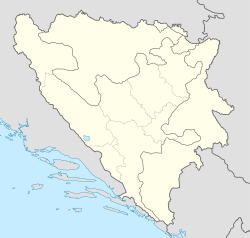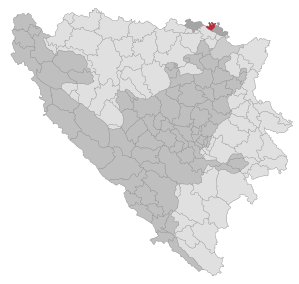Domaljevac-Samac
|
Domaljevac-Šamac Домаљевац-Шамац |
||
|
|
||
| Basic data | ||
|---|---|---|
| State : | Bosnia and Herzegovina | |
| Entity : | Federation of BiH | |
| Canton : | Posavina | |
| Municipality : | Domaljevac-Samac | |
| Coordinates : | 45 ° 4 ' N , 18 ° 35' E | |
| Height : | 85 m. i. J. | |
| Area : | 41.7 km² | |
| Residents : | 4,771 (2013) | |
| Population density : | 114 inhabitants per km² | |
| Telephone code : | +387 (0) 031 | |
| Postal code : | 76233 | |
| Structure and administration (as of 2020) | ||
| Mayor : | Stjepan Piljić ( HDZ BiH ) | |
| Website : | ||
Domaljevac-Šamac is a municipality in the north of Bosnia and Herzegovina in the Posavina canton . The community was re-established in 1998 as a result of the Bosnian War under the Dayton Agreement and has since been part of the Federation of Bosnia and Herzegovina .
The majority of the population of Domaljevac-Šamac calls themselves Croatians .
In Domaljevac-Šamac is the seat of the legislative authority of the canton Posavina ( Croatian Skupština Županije Posavske).
geography
location
Domaljevac-Šamac is located in the north of Bosnia and Herzegovina on the border with Croatia and therefore on the external border of the European Union since July 1, 2013 . The municipality extends along the southern bank of the Save River . To the east lies the municipality of Orašje . To the southwest, the municipality borders on Šamac and thus on the Republika Srpska .
The municipality is located in the Posavina region, rich in water, on the southern edge of the Pannonian Plain . A marsh area stretches along the Sava River and is regularly flooded.
Localities
The center of the municipality is the village of Domaljevac . In addition, the village of Bazik, as well as parts of the villages of Brvnik, Grebnice, Tursinovac and the border crossing to Croatia (Bosanski Šamac - Slavonski Šamac) belong to the municipality.
climate
Domaljevac-Šamac is located in the temperate zone and has a typical continental climate. The seasons are very distinctive. There are cold winters with average minimum temperatures of 0 ° C in the coldest month of January and hot summers with average maximum temperatures of 21 ° C in the warmest month of July, with temperatures below –10 ° C in winter and temperatures above 30 ° C in summer are.
The Posavina region has a Pannonian climate . Due to its location between the Mediterranean and the Black Sea, the Pannonian Plain , framed by high mountains, has some climatic peculiarities.
The Vb weather situation , which brings high amounts of rain, is typical . Because of the proximity to the Sava and the Bosna , there are regular floods. The first recorded flood of the Sava in Domaljevac was in 1812. More followed in 1823, 1852, 1866, 1932, 1936, 1937, 1940, 1942, 1945, 1961, 1971 and 2014.
history
Domaljevac is first mentioned as a populated place in 1548. Until 1910, a distinction was made between an upper and lower Domaljevac ( Croatian gornji i donji Domaljevac ). The first house in Grebnice was built around 1730.
The area was under Ottoman rule until Austria-Hungary annexed Bosnia and Herzegovina in 1878 and occupied it until the end of the First World War in 1918.
In the Kingdom of Yugoslavia , a municipality called Domaljevac was founded for the first time in 1926. The municipality consisted of the localities Domaljevac, Batkuša, Bazik, Brvnik, Grebnice, Liskovac and Odmut.
During the Second World War , the area of today's municipality became part of the Independent State of Croatia . As a result of the division of the national territory, today's municipal area was assigned to the Brčko municipality in the Posavje region. The town of Brod na Savi (now Slavonski Brod ) served as the administrative center of the district .
From the end of the Second World War and the establishment of the Socialist Federal Republic of Yugoslavia in 1945 by Josip Broz Tito until the outbreak of the Bosnian War in 1992, the area of today's municipality of Domaljevac-Šamac, together with today's municipality of Šamac , formed the municipality of Bosanski Šamac in the Yugoslav republic of Bosnia and Herzegovina.
Bosnian War 1992–1996
During the Bosnian War , the Bosnian Croats organized themselves militarily against the Bosnian Serbs and the Yugoslav People's Army . Domaljevac and the surrounding villages were defended by the 104th Brigade of the Hrvatsko vijeće obrane (HVO; Croatian for Croatian Defense Council). In 1993 the de facto state, the Croatian Republic of Herceg-Bosna, was founded, to which Domaljevac-Šamac belonged until the official dissolution in 1996.
Development since 1996 and re-establishment in 1998
The structures of the Herceg-Bosna were largely retained for the time being. In 1998 the parish was established in its current form based on the Dayton Agreement . The community has developed strongly since the end of the war. In addition to repairing the war damage, the infrastructure, such as the road network and the electricity and water supply, was expanded. Various services, shops, medical and nursing facilities as well as educational facilities were modernized or newly built, some with international support.
The development of certain areas is still slow. The refugees did not return to their homes, especially on the former front lines. Numerous war ruins can be seen in these areas to this day. In some cases there is a risk of mines. Since the minefields are also located in regularly flooded marshland, mine clearance is more difficult .
Floods 2014
The Balkan deep Yvette made from May 14, 2014, several days of continuous rain throughout Southeast Europe for the highest measured rainfall since records began 120 years ago. The rain in the interior of the country caused the Bosna to flow into the Save at Šamac with huge amounts of water. As a result, the dams broke and within a very short time a large part of the community area was flooded. The floods in Domaljevac-Šamac claimed two lives and caused enormous material damage.
population
National composition of the population
Before the Bosnian War in 1991, a majority of 98.02% described themselves as Croatians . According to the final results of the 2013 census, there are 4,771 people in Domaljevac-Šamac, 97.13% of them Croatians.
religion
The majority of the population is Roman Catholic . There is a parish in Domaljevac and Grebnice. Both parishes are subject to the Archdiocese of Vrhbosna . The Grebnice parish was established in 1992 as an independent parish from parts of the parishes Domaljevac and Tišina.
Diaspora
Even before the war, the community had a large number of guest workers abroad. During the war, a large part of the population fled via the Sava to Croatia or other countries. Often relatives living abroad offered the opportunity to be accepted by them. Despite the many returnees after the war, Domaljevac-Šamac still has a high proportion of the population abroad, which is typical for the entire region. For economic reasons, as well as a lack of prospects in the areas of education and employment, there is a strong trend towards emigration, especially to Germany , Austria and Switzerland . This trend can be observed across the region. Cities like Frankfurt am Main , Munich or Vienna have a large Croatian diaspora from the Posavina . Especially in the summer months as well as on public holidays such as Easter and Christmas, everyday life is busier than outside the holiday periods.
Culture
Dani općine Domaljevac-Šamac
Since 1998 the days of the community ( Croatian Dani općine) have been celebrated annually at the end of July . The festivities begin around July 20th with the celebration of the village patron of Grebnice, St. Elias ( Croatian Blagdan svetog Ilije). Colloquially, the festival is called Ilino and is traditionally celebrated with a Roman Catholic mass. On July 26th the celebrations around the feast of St. Anne ( Croatian sveta Ana), the village patroness of Domaljevac, take place. The highlight is the Roman Catholic mass and the street festival in the form of rides and market stalls. In addition to the church celebrations, various cultural and sporting events are offered these days. Among other things, there are performances by various cultural associations with traditional costumes and singing groups from the region, as well as various sports tournaments.
Sports
Soccer
HNK Mladost Domaljevac
With the football club HNK Mladost Domaljevac, founded in 1928, Domaljevac has a club that currently plays in the second division of the Posavina administrative district ( Croatian druga županijska liga Posavine). In the 2006/07 season Mladost was champion of the first division of the administrative district Posavina (Croatian prva županijska liga Posavine) and was able to play in the 2007/08 season in the second division of the North Federation (Croatian druga liga FBiH sjever). After a season, Mladost got down again. After the 2015/16 season, the team was relegated again.
The Mladost games are played on the Jelas sports field in the center of Domaljevac. The sports field has a grandstand that can accommodate a relatively large number of spectators. Accordingly, the sports field is also used for larger sporting events. Football games are sometimes held on the sports field with fundraising for humanitarian purposes.
NK Korpar Grebnice
The football club was founded in 1956. NK Korpar currently plays in the second division of the Posavina administrative district. From 2009 to 2012 NK Korpar was represented for three seasons in the first division of the Posavina administrative district. The games will be played on the Snoge sports field in Grebnice.
HNK 9. lipanj Bazik
The club was founded in the 1970s under the name "Mlada Bosna". The club was later renamed "Bosna" and carried the name until 1992. During the Bosnian War the club played under the name "HNK Bazik". After the war, the club took its current name "HNK 9. lipanj". Until 2015, the 9th lipanj was represented in the second division of the Posavina administrative district.
volleyball
HOK Domaljevac
With HOK Domaljevac Domaljevac owns a volleyball club in the Bosnian-Herzegovinian premier league of volleyball ( Bosnian Premijer liga BiH za odbojkaše). The club was founded in 1980 as OK Mladost and plays its games on the school sports facility in Grebnice.
literature
- Iljo Dominković: 85 godina "plavih s Jelasa". HNK "Mladost" Domaljevac. 1928-2013. Proventus natura, Cerna 2013, ISBN 978-953-57831-0-7 . (Croatian)
Web links
Individual evidence
- ↑ domaljevac . In: Poplave.ba - beta . ( poplave.ba [accessed January 30, 2017]). domaljevac ( Memento of the original from January 27, 2017 in the Internet Archive ) Info: The archive link was inserted automatically and has not yet been checked. Please check the original and archive link according to the instructions and then remove this notice.
- ↑ Broj mrtvih u poplavama u BiH narastao na 23 . ( index.hr [accessed January 30, 2017]).
- ↑ Velimir Jukić, Larisa Hasanbegović: Census of Bosnia and Herzegovina 2013, results. (PDF) Agencija za statistiku Bosne i Hercegovine, June 30, 2016, accessed on January 27, 2017 (English, Bosnian).
- ↑ SLUŽBA ZA ODNOSE S JAVNOŠĆU: Dani općine Domaljevac-Šamac . In: Vlada Županije Posavske . July 25, 2016 ( zupanijaposavska.ba [accessed January 26, 2017]).
- ↑ ARHIV PRVENSTAVA - Posavina Sport. Retrieved January 30, 2017 (hr-HR).
- ↑ Neuobičajen potez navijača Dinama i Hajduka u Posavini - Posavina Sport . ( posavinasport.com [accessed January 30, 2017]).
- ↑ BAZIK.info: I naša najvažnija sporedna stvar na svijetu . ( bazik.info [accessed February 1, 2017]).










